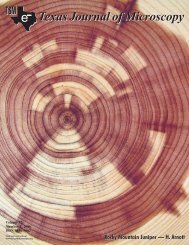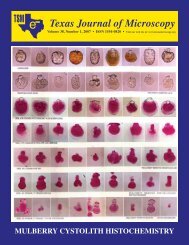Texas Journal of Microscopy - Texas Society for Microscopy
Texas Journal of Microscopy - Texas Society for Microscopy
Texas Journal of Microscopy - Texas Society for Microscopy
You also want an ePaper? Increase the reach of your titles
YUMPU automatically turns print PDFs into web optimized ePapers that Google loves.
Figure 10. 1. A. fruit <strong>of</strong> Cordyline australis with viviparous seedling<br />
extending out <strong>of</strong> the fruit wall. B, C. Young seedlings with rough<br />
primary root; in the latter the root hairs had grown into the fruit<br />
wall and had to be broken out with <strong>for</strong>ce. Adapted from Arnott, H.<br />
J. Vivipary in Cordyline australis Hook. Madroño 15(3):71-73.<br />
from some observations I made in the backyard <strong>of</strong> our Berkeley flat<br />
where specimens <strong>of</strong> Cordyline australis were growing. These palmlike<br />
plants have very large inflorescences with hundreds <strong>of</strong> white<br />
flowers. Later the flowers become hundreds <strong>of</strong> fruits. While studying<br />
them I noticed that some seeds had germinated, in situ, and were<br />
breaking out <strong>of</strong> the fruit coat (Fig 10). I told Annetta Carter about this<br />
and she suggested that I write a brief paper and submit it to Madroño,<br />
which I did. The phenomenon <strong>of</strong> seed germination while still in the<br />
ovary is called vivipary, thus the title <strong>of</strong> the paper was “Vivipary in<br />
Cordyline australis.” It is a small paper but it was a start!<br />
You have most likely noted that much <strong>of</strong> my early research involves<br />
the genus Yucca. Those interesting plants were obvious subjects <strong>for</strong><br />
me. Some <strong>of</strong> my earliest memories involve viewing the extraordinary<br />
flowering stalks (inflorescences) <strong>of</strong> Yucca whipplei (sometimes called<br />
Figure 11. Lena Alderman Donnelly, my maternal grandmother,<br />
with a flower stalk <strong>of</strong> Yucca whipplei on the porch <strong>of</strong> 2457 Pomeroy<br />
Ave., Los Angeles, Ca, 1909. The photo was taken and processed<br />
by Nellie Alderman, my maternal great grandmother.<br />
“Our Lord’s Candle”) and the bizarre <strong>for</strong>ms <strong>of</strong> Yucca brevifolia (The<br />
Joshua Tree). Pictures <strong>of</strong> my great grandparents, grandparents,<br />
mother, father, and aunts with these flowers are abundant in our<br />
photographic memoirs (Fig. 11). I continued to study Yucca in my<br />
dissertation work done under the direction <strong>of</strong> Dr. Adriance S. Foster<br />
at the University <strong>of</strong> Cali<strong>for</strong>nia, Berkeley. My third Ph.D. student,<br />
Harry T. Horner, also studied Yucca seed ultrastructure as a part<br />
<strong>of</strong> his dissertation work. One <strong>of</strong> Horner’s Ph.D. students, Albert<br />
Kausch, also worked on Yucca. Another <strong>of</strong> my Ph.D. students, Genie<br />
Brackenridge, studied the development <strong>of</strong> calcium oxalate crystals<br />
Figure 12. A. Embryo sac <strong>of</strong> Y. whipplei with egg apparatus, antipodals<br />
and fusion nucleus within the embryo sac. B. Young globular phase<br />
embryo with suspensor. Adapted from the dissertation <strong>of</strong> HJA.<br />
in the roots <strong>of</strong> Yucca torreyi in her dissertation. Later, using crystals<br />
isolated from Y. rupicola, Fred Pautard, Hugo Stinfink and I worked<br />
out the crystal structure <strong>of</strong> calcium oxalate monohydrate. Even now<br />
I have two new yucca investigations which are on going.<br />
Yucca embryology was the subject <strong>of</strong> my first pr<strong>of</strong>essional paper<br />
given at a major scientific meeting. The paper was given at the 1957<br />
American Botanical <strong>Society</strong> Meeting at Stan<strong>for</strong>d University (Fig.<br />
12). My paper (usually these presentations are called “papers”)<br />
dealt with embryo sac development in several species <strong>of</strong> Yucca and<br />
used Kodachrome slides. Most botanists had never seen embryo sac<br />
development depicted in color. For its time it was unusual, it might<br />
even have been high tech <strong>for</strong> the time, and it got excellent reaction<br />
from the audience. I made the 35 mm slides using my own equipment:<br />
a Leica camera back attached to a photo tube with an in/out photo<br />
(light) detector. The detector, wired to a galvanometer, was used to<br />
determine the amount <strong>of</strong> light and hence calculate the exposure.<br />
Naturally everyone’s first paper is a landmark; however, <strong>for</strong> me the<br />
greatest moment <strong>of</strong> that meeting was hearing Dr. Katherine Esau present<br />
some <strong>of</strong> her research. We were in the same session and our papers were<br />
given in the same dreary room with several pillars making viewing <strong>of</strong><br />
the screen difficult. Dr. Esau had exactly the same facilities <strong>for</strong> her talk<br />
as I did. It was bizarre, one <strong>of</strong> the <strong>for</strong>emost botanist in the world was<br />
doing just what I, a beginning graduate student, did; how very cool.<br />
Her book, “Plant Anatomy” had just come out in 1953 and it became<br />
an instant classic. I remember at the end <strong>of</strong> her presentation someone<br />
pointed out a “possible mistake.” With complete composure and self<br />
confidence she simply said, “I stand corrected.” End <strong>of</strong> controversy! Up<br />
to that time I had no idea that scientists could be that elegant.<br />
The American Botanical <strong>Society</strong>’s Meetings was where the<br />
“big boys” went to “pat” each other on the back. It was my first<br />
introduction to “cigar smoking botanists with big names.” I got<br />
to meet many <strong>of</strong> them because my pr<strong>of</strong>essor was one <strong>of</strong> them. At<br />
that time, most people still rode trains to meetings; three days and<br />
nights on a train cemented many a botanical friendship, even <strong>for</strong><br />
teetotallers. The contacts made at meetings <strong>of</strong> this kind are (were)<br />
absolutely necessary; they are indispensable <strong>for</strong> anyone who wants<br />
to be an “upwardly mobile botanist.” The internet and other means<br />
Tex. J. Micros. 37:2, 2006<br />
69




